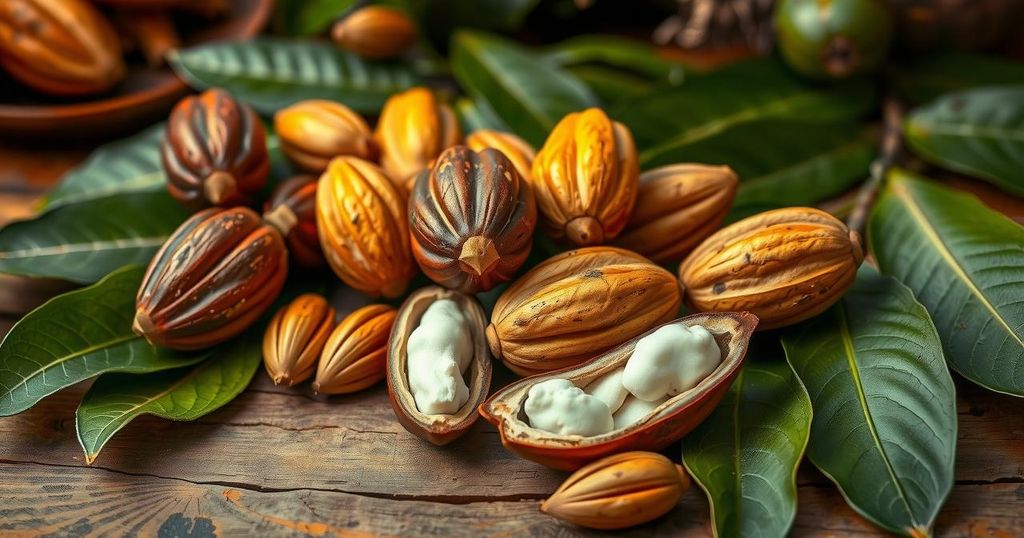Papua New Guinea Cocoa and Coffee Exports: Market Dynamics and Trends
Papua New Guinea’s cocoa exports reached PGK1,233 million in 2024, eclipsing coffee’s PGK989 million. Although cocoa witnessed record prices and growth, coffee is anticipated to reclaim its dominance in 2025 with forecasts of PGK1,580 million revenue. Global issues impacting coffee and cocoa markets highlight the volatility of PNG’s agricultural exports.
Papua New Guinea (PNG) witnessed a remarkable year for cocoa exports in 2024, generating PGK1,233 million in revenue, thereby surpassing coffee revenues of PGK989 million for the first time in its history. However, this shift in ranks is expected to be short-lived as cocoa production cannot be significantly ramped up due to historically small crop sizes. Conversely, coffee is anticipated to have a robust year in 2025 following a down year, where yields may alternate between high and low seasons.
The coffee market is poised for growth, with recent price increases linked to adverse weather conditions impacting Brazil’s crop. Expectations indicate coffee prices could reach unprecedented levels, enabling it to reclaim its historical dominance over cocoa. Forecasts for export revenues in 2025 predict PGK1,580 million for coffee and PGK1,363 million for cocoa, leading to a total revenue of PGK3 billion, surpassing the 2024 total of PGK2,222 million.
Cocoa production globally has suffered a 13.1% decline, primarily due to drought and disease affecting critical producers like Ghana and Cote d’Ivoire. Although cocoa prices soared to an average of USD8,214 per ton, the recovery of the crop remains uncertain. Upcoming rains in West Africa may suggest a more favorable mid-crop, yet demand moderation in Europe could stabilize prices around USD8,000 per ton.
Coffee production experienced a dip in late 2024, further compounded by decreased projections of Brazil’s Arabica beans owing to La Niña’s effects on flowering. With Brazil contributing significantly to the global coffee bean supply, this production setback is likely to escalate coffee prices, which reached a peak of USD4.39 per pound in February. PNG’s coffee exports, although reduced in 2024, are expected to rebound robustly in 2025, potentially reaching one million bags.
Despite a slight decline in coffee exports in 2024, the upcoming seasons look promising, with the expectation of more than 100,000 bags exported monthly beginning in August. Record prices will incentivize farmers, but there are concerns that increased costs in the supply chain may challenge cash flow management.
Cocoa prices in PNG have surged, leading to exports of approximately 39,000 tons in 2023, marking a modest increase. However, a shift of farmers from cocoa to balsa wood plantations in recent years has impeded production growth even amid record prices. Nevertheless, ongoing support for farmers may yield 42,000 tons of cocoa exports in 2025.
Historically, PNG’s coffee and cocoa revenues have favored coffee, which is expected to regain its edge in export receipts in 2025, spurred by higher export volumes and significant price increases. PNG remains influenced by global market dynamics, requiring consistency with international prices to maintain competitiveness in coffee and cocoa exports.
The article, developed by ANZ Group’s KISHTI SEN, TOM KENNY, and commodity strategist SONI KUMARI, underscores the volatile yet promising future for PNG’s cocoa and coffee industries, emphasizing the balance of production capacity and market readiness.
The views expressed are not necessarily those of The Fiji Times, which initially published this article on March 14, 2025.
In conclusion, Papua New Guinea has achieved a historic milestone by surpassing coffee exports with cocoa, generating substantial revenues in 2024. However, the prospects favor coffee regaining its dominance due to expected higher production and prices. Despite challenges from global market fluctuations and local production issues, the anticipated increase in coffee and cocoa export volumes positions PNG for a promising economic outlook in the coming years. Continuous monitoring of market dynamics will be essential for maintaining competitiveness in these export sectors.
Original Source: www.fijitimes.com.fj




Post Comment